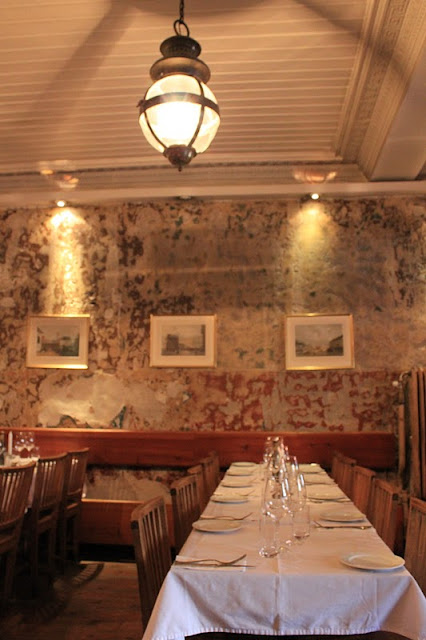The buildings in Skansen have been taken from all over Sweden and moved to the museum. Every Swedish region and its way of life is represented here. We were running short on time, so we decided to head to the Skåne farmstead area, as that is where our relatives are from and would be most indicative of the lives led by my great-grandfather and his family.
The cow pictured above is undoubtedly the biggest cow I have ever seen. The ducks were huge too. I wonder if this is because of tourists sneaking them food or if they are just some huge breed that I have never see before.
I was drawn to the fences here and how they differ from American styles. Even the rock wall is different, with so many flat rocks mixed in. I also love thatched roofs. My favorite house in Vail boasts one.
This is inside the Skåne farmers' home. There was wallpaper covering almost every surface of the structure, except for the floors, which were often covered in a collage of multiple small carpets. The ceilings were drastically shorter than those we are accustomed to - my head almost reached the ceiling! I felt like I was in some fun house at an amusement park.
 |
| a very cool compost center |
The windmill is a departure from the Skåne region, I blelieve. However, windmills like this one were quite common all around Sweden. Newer versions have obviously replaced them and I was surprised at how many there are dotting the countryside. My relatives said that nobody really likes them and nobody wants to have one nearby, but that everyone understands that they are necessary going into the future.
 |
| A view of the city from Skansen |
After spending half of our day in Skansen, we walked down the road to the other two museums on the island - the Vasa Museum and the Nordic Museum.
The Vasa Museum tells the story of this HUGE ship. The ship, commissioned by the Swedish king, embarked on her maiden voyage in 1628 and only traveled about 1300 meters before sinking in Stockholm's harbor. The counterbalance weight in the hull was not enough to balance out the enormous upper part of the ship. Several attempts to raise the ship take place through 1629, but to no avail. Aside from a few dives, the Vasa lay relatively forgotten on the ocean floor until the 1950s when two divers, Anders Franzén and Per Edvin Fälting begin a new campaign to rescue the ship. The Vasa is finally lifted from the waters in 1961.
Upon her resurfacing, Swedish researchers undertake a huge endeavor to preserve the Vasa and learn about the life of the men on board. The conservation of the wood of the ship, combined with many more dives to uncover anything else left in the harbor, takes years. In 1988, the Vasa sailed for the final time from the harbor into the museum. The museum opened in 1990.
The incredibly story of the Vasa is even more impressive when you can see the enormity of the ship in person. If you look at the picture above, you can see some people in the frame to give you a sense of scale. However, I don't believe that even does it justice. Because of the dimmed lighting in the museum, picture taking was quite difficult.
The Nordic Museum is a Swedish cultural history and ethnographical museum that documents Swedish life from the early 1500s to present day. There are temporary modern exhibitions as well as permanent as permanent displays about toys, traditions and holidays, and home furnishings and decor among other things. The museum offers a very comprehensive look at Swedish culture and how it has evolved throughout the centuries.
I love learning about the day to day life of the past, so seeing how Swedish food, religions traditions, and dinnerware have changed over the centuries really intrigued me.
After shutting down the Nordic Museum, we wandered along the waterway back to Stockholm proper. It was the perfect end to a great vacation. I think we all would wished we didn't have to fly out the next morning. We will just have to make sure there is a next time. Skål.
Video of the Vasa resurfacing from the Vasa Museum website.
















































